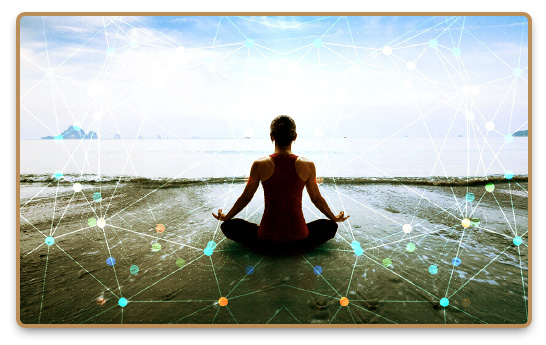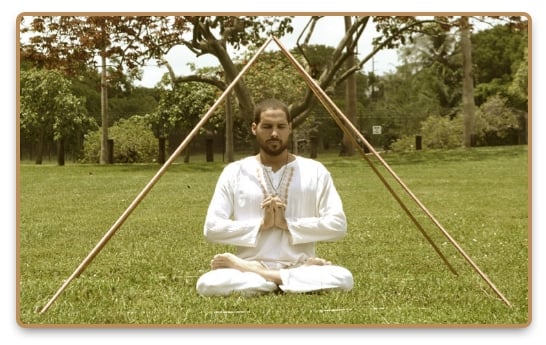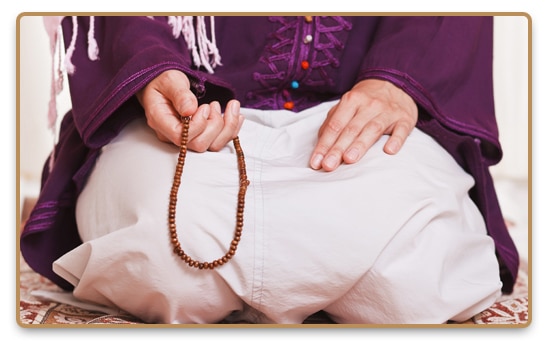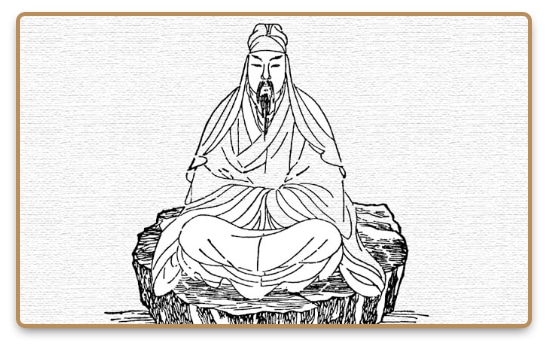
05 Feb Taoist Meditation
Definition
Taoist meditation (also known as daoist meditation) is a collection of meditation techniques connected to the Taoist philosophy. It would go beyond the scope of this article to discuss all the methods of meditation related to Taoism, but they generally relate to three categories: ding (or concentration), guan (or insight/observation), and cun (or visualization).
From the outside, Taoist meditation may resemble a lot of other styles of meditation. It does share numerous aspects, especially with those of the Buddhist tradition, but Taoist meditation has a particular focus on the manipulation of qi / chi, our life energy. The overall goal of most of these practices is to find harmony with the universe. Some people call this “returning to the source”.
The Roots of Taoism
The roots of Taoism spread back to the writings of Chinese philosopher Lao Tzu from his famous Tao Te Ching, although scholars disagree on when he lived or if he was even a real person. Yet, this is irrelevant to the influence of the text itself. Even though there is some mention of meditation in this work, the Taoist meditation practice is something that has developed and evolved over time. Nowadays much of the practice seems focused on energy manipulation and can have some connections to new age philosophies.

Don't think you can attain total awareness and whole enlightenment without proper discipline and practice. This is egomania. Appropriate rituals channel your emotions and life energy toward the light. Without the discipline to practice them, you will tumble constantly backward into darkness.
Practice
Concentration, Observation and Visualization
Concentration meditation or ding is very similar to the Buddhist practice of samadhi. The idea is to bring the full focus of the mind onto a single thought or object. Although the word cun is often translated as “visualization” the focus is on being present, or rather viewing oneself. By being able to have a clear image of ourselves, we can thus better control our energy. Some Taoist meditation practices will have people focus on the image of god before us. Ultimately, the goal is to bring oneself to a state of just existing. Guan is “observation” or “insight” , sometimes translated as “to scrutinize”, which is to be open and aware of a variety of things, including one’s physical self, energies, or the world.
See How to Deepen Taoist Meditation Practice with a simple device.
Although these ideas are at the core of Taoist meditation, some of the practical applications (at least in the modern sense) utilize these ideas, just not in their purest sense. There are many different meditation methods within Taoism and this is no way meant to be comprehensive, just a quick overview of a few of them.
Body Position in Taoist Meditation
Like in most forms of meditation, Taoist meditation is usually done while sitting, typically cross-legged with an aligned spine. Make sure that you are not sitting with a forced level of straightness. Try to find balance so that it’s not painful for the duration of the session. Be sure to elongate the neck by lowering the chin slightly. This is said to help the energy flow more freely throughout the body.
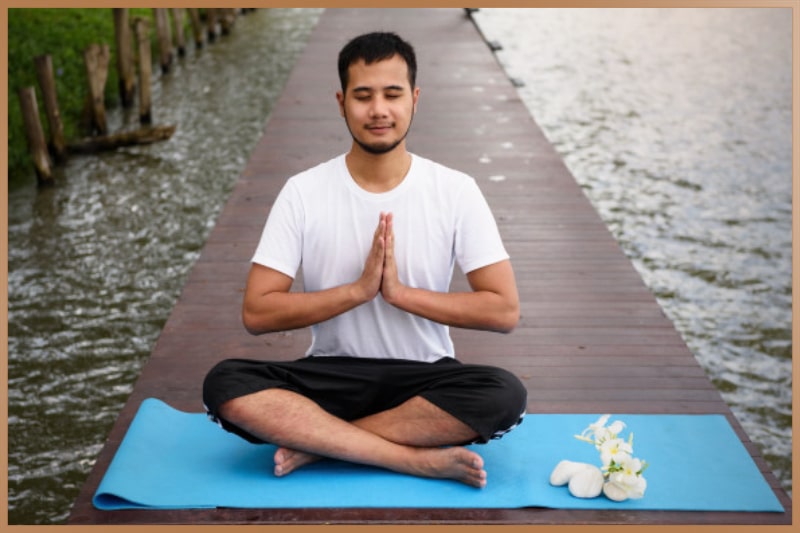
If a cross-legged position is uncomfortable, some people will choose to sit on a chair with the feet firmly placed on the ground. The hands are rested, palm up in the lap. Some even recommend smiling a bit during the meditation and placing the tongue against the upper palate to stimulate saliva production. Some people find better results from closing their eyes, but it does come with the risk of falling asleep. It is typically recommended to close your eyes halfway and let your gaze soften.
Proper Breathing is Important
Try to take deep breaths, being sure to use your diaphragm. One method to encourage deep breathing is to focus on the lower dantian and visualize the breath entering and leaving the body through the navel cavity. This is sometimes called prenatal breathing.
The different breathing techniques within the Taoist meditation tradition is its own disciple and worth exploring deeper. Among the most famous is Zhuanqi. In general, while meditating, it’s just important that you breathe deeply at a slow, even pace. To help focus the mind, many find benefit by starting your meditation with counting your breaths.
Selection of Taoist Meditation Methods
Visualization Practice
One common Taoism meditation method is a visualization practice. After you’ve gotten yourself into a proper position and have started breathing, begin at your head and focus on releasing the tension down your body until you reach your feet. Take note of areas that are tight or have pain. It helps to visualize these are dark spots. To bring in energy, imagine that your breath is taking in light that envelops your body, dissolving these dark areas. Then, as you breathe out, let the pain and stress flow out of you as a dark mist.
Others claim that the color of the light can change the focus of the meditation, that certain ailments are best treated by imagining different colors of light. For example, green is said to help with anxiety. When you are finished, it is helpful to imagine your body as cleansed.
The Energy Ball Visualization
Meditators are typically instructed to focus on the lower dantian, although women will sometimes put their focus higher, in the middle dantian, which is located between the breasts. Some people like to visualize a ball of energy at these points, choosing a size that feels right to you. Let this energy ball slowly flow up and down your body, cleansing your body as it moves. When finished, let it rest once again at the starting point and allow the energy to emanate to your heart.

Emptiness Practice
Another common Taoist meditation method is an emptiness practice. It follows a similar beginning to those listed above, but it diverges after a scan of the body. Instead of focusing on energy, try to focus on the idea of emptiness. Purge the mind of all thoughts and feelings. Just visualize there being a void of the mind.
Others have found success by trying to find a sense of complete stillness. Time still flows, energy still flows, but you are offering no resistance. Thoughts may flow, but let them just pass by.
How Long and How Often Should One Practice Taoist Meditation?
It is usually recommended that people aim for twenty to thirty minute sessions of Taoist meditation. This is usually enough time to get the full benefit before many feel uncomfortable. If you have little experience with meditation or sitting on the floor for an extended amount of time, you can still gain positive effects by beginning with only ten minutes before increasing the length as they become better at it.
When finished with your meditation, it is good to give yourself a few minutes to adjust again to being out of meditation. Otherwise, it might be a bit jarring of a contrast. This can allow you to bring some of that peace with you into your day.
Taoist Meditation is Just One Form of Practising Taoism
One doesn’t need to practice the Taoist faith to get the full benefit of the meditation practices, though one could argue that the Taoist meditation is a form of practising Taoism. It can be helpful to learn a bit more about Taoism in general or even find a temple where you can learn some of the techniques and ideologies directly from experienced teachers.
It can also help to combine these meditation practices with other styles as well, including tai chi and qigong. The former is a great way to prepare the body for an extended period of sitting, much like people use hatha yoga in other traditions.
Benefits
Given that there are a wide variety of meditation methods involved with Taoism, there doesn’t seem to be very much focused research on any specific method. The benefits of meditation in general are becoming more accepted by the scientific community, though the quality of many of meditation studies are a bit dubious.
Possibly as a consequence of deep breathing, adopting a regular meditation practice can help people breathe in a more healthy way in general, which can lead to a lessening of stress and anxiety. In general, finding a decrease in cortisol can be beneficial for many, especially because stress has been shown to have a negative effect on the function of the immune system. Meditation has been shown to lower blood pressure and heart rate. There is some suggestion that it can also aid in promoting attention and cognitive function. Another study has shown that meditation can help increase the density of the brain’s grey matter and improve memory.

Start practicing today
The Egely Wheel is trusted by thousands of people who practice yoga, telekinesis, meditation and healing. This device is the best solution for measuring your energy flow and efficiency of healing, and you get instant feedback.
The Healing Powers of Qi Energy
Some more mystically-inclined practitioners like to list some tall sounding claims associated with taoist meditation. Much of these are due to the healing powers of qi / chi energy. For example, it is said that it can increase vibrancy, with de-ageing properties. Although proponents of energy healing do not seem dissuaded by the research, there exists very little evidence of vital energy and is generally regarded as pseudoscience.
Still, there exists some evidence that a belief in vital energies can amplify some of the effects. The more meaning we assign to a placebo, the stronger it is, so this could show there is some benefit in visualizing energy in this way.
15 Sources +
Egely Wheel has strict sourcing guidelines and relies on peer-reviewed studies, academic research institutions, and medical associations. We avoid using tertiary references.
- The Encyclopedia of World Religions – https://books.google.no/
- With mindfulness, life’s in the moment – https://news.harvard.edu/
- Evaluation of an adaptive automation system using three EEG indices with a visual tracking task – https://pubmed.ncbi.nlm.nih.gov/
- Taoist Meditation: 8 Taoist Meditation Techniques For Inspiration And Inner Peace – https://relaxlikeaboss.com/
- Taoist Meditation – https://taoisma4.weebly.com/
- Bioenergetic Fields – http://www.colorado.edu/
- 3 Powerful Taoist Meditation Techniques to Tame the Mind, Open the Heart and Awaken Intuitive Abilities – https://www.consciouslifestylemag.com/
- How Stress Affects the Immune System – https://www.psychologytoday.com/
- Deconstructing the Placebo Effect and Finding the Meaning Response – https://www.researchgate.net/
- Health Benefits of Meditation: What the Newest Research Shows – https://www.researchgate.net/
- Mindfulness Practice Leads to Increases in Regional Brain Gray Matter Density – https://www.researchgate.net/
- Meditation Practices for Health: State of the Research – https://www.researchgate.net/
- Sudarshan Kriya Yogic Breathing in the Treatment of Stress, Anxiety, and Depression: Part I—Neurophysiologic Model – https://www.researchgate.net/
- The Routledge Encyclopedia of Taoism – https://www.routledge.com/
- How to Practice Taoist Meditation – https://www.wikihow.com/
Discover more types of Meditation
Mindfulness Meditation
Mindfulness meditation is built upon drawing focus to the present moment so that it can be practiced anywhere. It has a myriad of benefits. Learn more...
Pyramid Meditation
Pyramid meditation is the practice of sitting beneath a four-sided pyramid structure for the use of amplifying the effects of meditation. Learn more...
Sufi Meditation
Sufi meditation is a varied style of meditation directly connected to the Islamic faith and Sufism. It is also called Murāqabah. Learn more...

